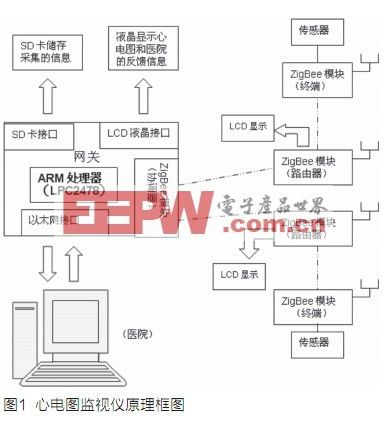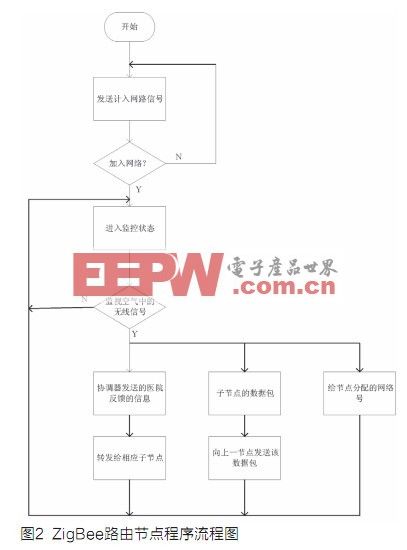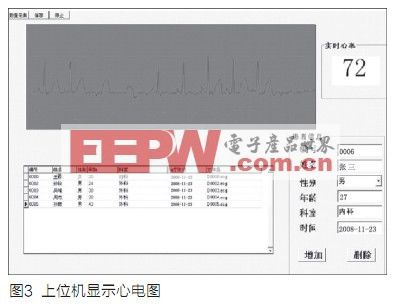ZigBee wireless sensing ECG monitor technology This paper designs a home telemedicine monitor based on ZigBee wireless sensor network. The image is displayed through the integrated LCD support provided by the LPC2478 based on ARM7 core. At the same time, the signal is stored on the SD card and transmitted to the 10/100 Ethernet. The hospital, the hospital feedback information and display it on the LCD, while the community clinic's coordinator gateway wirelessly returns the diagnosis results to the corresponding home and displays it on the home LCD, and the user can transfer the result to the home computer for storage. The design makes it easy to build a health check network that can be diagnosed by a doctor without complicated operations, and is very suitable for home users. System implementation The sensor in the system is used to detect the weak signal of the electrocardiogram, and then encoded by the amplification and filtering, and then sent to the gateway based on the ARM and ZigBee coordinator module through the ZigBee wireless module, and sent to the upper computer through the peripheral interface for display processing. Then, it is transmitted to the community clinic via Ethernet. The clinic then returns each person's information to their homes through the ZigBee wireless module, and displays the processing information of the hospital feedback on the LCD. By selecting the chip reasonably, it is possible to achieve low power consumption, low cost, and detect weak ECG waveform changes. Technical characteristics 1. LPC2478 can realize a variety of high-bandwidth peripheral synchronization operations for information processing and real-time display. 2. Adopt ZigBee wireless transmission based on CC2430, low cost, low power consumption, strong self-organizing network, reliable transmission, small size and easy to carry. 3. The community clinic can store the diagnosis results of the entire community owner, and can provide necessary reminders and preventions for each owner's diagnosis results, effectively reducing the incidence rate. 4. The user can store the diagnosis on the home computer for easy backup. Hardware platform The embedded wireless sensor ECG monitor hardware includes main control, power supply and reset, LCD display, ZigBee coordinator, ZigBee router, ZigBee endpoint, sensor and amplification filter conditioning circuit, SD card storage, 10/100 Ethernet, etc. 9 functional modules. The hardware design block diagram is shown in Figure 1. Master module The module uses the LPC2478 microcontroller based on the ARM7TDMI-S core. It is powerful and cost-effective. It contains an LCD controller that supports 10/100 Ethernet, full-speed (12Mbps) USB2.0, USB OTG and 2 CAN2. 0B channel, 4 UARTs, 1 SPI interface, 2 synchronous serial interfaces (SSP), 3 I2C and 1 I2S interface, with on-chip high-speed 512KB Flash, 98kB RAM, one external memory interface, 10 bits A/D and D/A converter, an internal RC oscillator and an SD memory card interface, eliminating the communication bandwidth bottleneck, facilitating the expansion of the USB interface, JTAG debug interface, touch screen, less external expansion chips, and ultra-small The LQFP208 package ensures the miniaturization of the instrument, and its powerful functions can meet the requirements of the embedded system mC/OS-II and humanized human-machine interface. The LPC2478 is ideal for portable electronics applications. ZigBee module Integrated ZigBee radio frequency (RF) front end, memory and microcontroller on the CC2430 chip, the enhanced 8051MCU core delivers up to 8x the performance of an industry-standard 8051 microcontroller core; with 32/64/128 kB programmable flash and 8 kB of RAM; also includes 8 input channels 8 to 14 bit selectable analog-to-digital converter (ADC), 4 timers; 2 powerful USARTs supporting several sets of protocols; wide voltage range ( 2.0~3.6 V); hardware supports CSMA/CA function; only 0.9mA current loss in sleep mode, external interrupt or RTC can wake up the system, current loss is less than 0.6mA in standby mode, external interrupt can wake up the system; integration 2.4GHz RF radio transceiver conforming to IEEE802.15.4 standard; has excellent radio receiving sensitivity and strong anti-interference; high integration, less peripheral components required; expansion board includes serial port and LCD display, etc. for data string Line transfer and data display. Signal acquisition and conditioning The AD620, a low-power, high-precision instrumentation amplifier, is used as the core of the preamplifier. The AD620 features high accuracy, high input impedance, low input bias current, low input offset current, low noise, low power consumption, and small size, making it ideal for use in medical instrumentation systems. The low-pass filter circuit uses the Butterworth fourth-order filter TLC04, which is low-cost, easy to use, and provides a sophisticated fourth-order low-pass filter. The buffer is an in-phase voltage follower that acts to increase the system input impedance and common mode rejection ratio. The limiter uses a dual T band rejection filter to filter out 50Hz power frequency interference. The main stage amplifier uses a full-supply output amplitude quad operational amplifier, the TLC2274, which provides excellent AC performance and provides lower noise, lower input offset voltage, and lower power than conventional CMOS op amps. The program flow chart of the ZigBee routing node is shown in Figure 2. Data processing and display description This design uses differential threshold method to detect QRS wave. The basic idea is to perform differential operation on the filtered ECG signal, find the threshold of the difference to determine the falling edge of the QRS waveform, and then determine the QRS according to a certain time window and amplitude threshold. The characteristic point of the wave. Scanning electrocardiography, the main principle is: draw points from left to right, in turn display the corresponding position, while the new point will cover the original point, there is a buffer in the middle to brush off the old point. When drawing to the far right, draw a picture from the far left and repeat it all the time. The host computer displays the waveform diagram as shown in Figure 3. The off-grid inverter is an inverter used in off-grid solar power generation systems. Its main function is to convert the direct current generated by solar panels into alternating current to meet the power demand in off-grid environments, such as in remote areas, In camping, boats, or moving vehicles. off grid solar inverter,off grid 3 phase inverter, off grid solar power inverter, off grid solar inverter 5kw, off grid solar inverters for sale Ningbo Autrends International Trade Co., Ltd. , https://www.china-energystorage.com


Main effect:
Converts the direct current generated by solar panels into alternating current to supply the power needs of homes, mobile devices, or other electrical appliances.
Off-grid inverters are usually equipped with battery energy storage systems, which store excess power so that they can continue to supply power when the solar panels cannot generate enough power.
Differences from On-Grid Inverter:
Connection method: Off-grid inverter is an inverter used in the off-grid system and does not need to be connected to the grid. They are often used in places where there is no access to the grid, such as remote areas, wild camping, or outlying islands.
Grid requirements: Unlike on-grid inverters, off-grid inverters do not need to meet grid requirements and standards because they are not connected to the grid. They can operate independently and can be adapted to different off-grid environments.
Self-sufficiency: The off-grid inverter is equipped with a battery energy storage system, which can store excess electricity so that it can continue to supply electricity when the solar panels are unable to generate electricity. This makes the off-grid system self-sufficient and not dependent on an external grid for power.
Application scenarios: Off-grid inverters are widely used in remote areas, camping, ships, mobile vehicles, and some special-purpose scenarios. On the other hand, grid-connected inverters are mainly used in home, commercial, and industrial photovoltaic power generation systems connected to the grid.
In general, the main function of the off-grid inverter is to convert the direct current generated by the solar panels into alternating current to meet the power demand in the off-grid environment and achieve self-sufficiency by being equipped with a battery energy storage system. In contrast, on-grid inverters connected to the grid are mainly used to integrate solar power into the grid, realize the interaction between solar power and the grid, and comply with the requirements and standards of the grid.